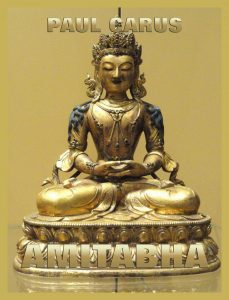Amitabha – A Story Of Buddhist Theology – Paul Carus
The story of Amitabha has a historical setting in the ascendancy of the kingdom of Gandhara, under King Kanishka, whose interest in Buddhism and whose connection with Acvaghosha, the great Buddhist philosopher, are well known. The plot gives ample opportunity in discussion and incident to explain and illustrate some of the cardinal points of Buddhism, especially in regard to the way of salvation and the God-conception represented by Amitabha Buddha, the Source of Infinite Light and the Standard of Being, as distinct from the Brahman idea of a conscious personal deity. Contents: The Ordination. The Novice. The God Problem. Kevaddha’s Story. The Confession. Gandhara. King Kanishka. Magadha. Acvaghosha. Amitabha. The Conspiracy. The Man-Eating Tiger. The Buddhist Abbot And The Brahman. The Parable Of The Elephant. The Double Wedding.
Format: Paperback.
Amitabha – A Story Of Buddhist Theology.
ISBN: 9783849674779.
Available at amazon.com and other venues.
Doctrine of the Amitabha (from wikipedia.com)
According to the Larger Sūtra of Immeasurable Life, Amitābha was, in very ancient times and possibly in another system of worlds, a monk named Dharmakāra. In some versions of the sūtra, Dharmakāra is described as a former king who, having come into contact with Buddhist teachings through the buddha Lokeśvararāja, renounced his throne. He then resolved to become a buddha and so to come into possession of a buddhakṣetra (“buddha-field”, a realm existing in the primordial universe outside of ordinary reality, produced by a buddha’s merit) possessed of many perfections. These resolutions were expressed in his forty-eight vows, which set out the type of buddha-field Dharmakāra aspired to create, the conditions under which beings might be born into that world, and what kind of beings they would be when reborn there.
In the versions of the sutra widely known in China, Vietnam, Korea and Japan, Dharmakāra’s eighteenth vow was that any being in any universe desiring to be born into Amitābha’s pure land (Chinese: 净土; pinyin: jìngtŭ; Japanese pronunciation: jōdo; Korean: 정토; romaja: jeongto; Vietnamese: tịnh độ) and calling upon his name even as few as ten times will be guaranteed rebirth there. His nineteenth vow promises that he, together with his bodhisattvas and other blessed Buddhists, will appear before those who call upon him at the moment of death. This openness and acceptance of all kinds of people has made belief in pure lands one of the major influences in Mahāyāna Buddhism. Pure Land Buddhism seems to have first become popular in Gandhara, from where it spread to Central Asia and China.
The sutra goes on to explain that Amitābha, after accumulating great merit over countless lives, finally achieved buddhahood and is still residing in his land of Sukhāvatī, whose many virtues and joys are described.
The basic doctrines concerning Amitābha and his vows are found in three canonical Mahāyāna texts:
Infinite Life Sutra
Amitabha Sutra
Amitayurdhyana Sutra
Through his efforts, Amitābha created a pure land called Sukhāvatī (Sanskrit: “possessing happiness”) . Sukhāvatī is situated in the uttermost west, beyond the bounds of our own world. By the power of his vows, Amitābha has made it possible for all who call upon him to be reborn into this land, there to undergo instruction by him in the dharma and ultimately become bodhisattvas and buddhas in their turn (the ultimate goal of Mahāyāna Buddhism). From there, these same bodhisattvas and buddhas return to our world to help yet more people.
Amitābha is the buddha of comprehensive love. He lives in the West (represented as a meditating Buddha) and works for the enlightenment of all beings (represented as a blessing Buddha). His most important enlightenment technique is the visualization of the surrounding world as a paradise. Who sees his world as a paradise, awakens his enlightenment energy. The world can be seen as a paradise by a corresponding positive thought (enlightenment thought) or by sending light to all beings (wish all beings to be happy). After the Amitābha doctrine, one can come to paradise (in the Pure Land of Amitābha), if they visualize at their death Amitābha in the heaven (sun) over their head (western horizon), think his name as a mantra and leave the body as a soul through the crown chakra.
(The text of the last section was taken from a Wikipedia entry and is available under the the Creative Commons Attribution-ShareAlike License.)
Publisher’s Note: This book is printed and distributed by Createspace a DBA of On-Demand Publishing LLC and is typically not available anywhere else than in stores owned and operated by Amazon or Createspace.

